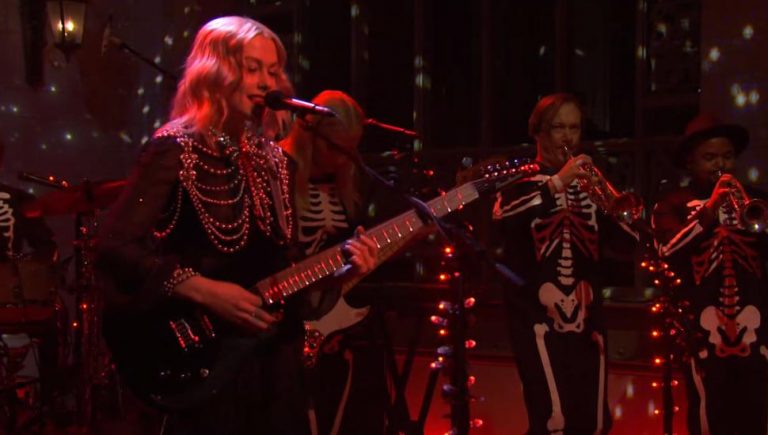Phoebe Bridgers had the audacity to smash a guitar on the SNL stage and the music world is still overwhelmed by it.
Destroying instruments is such a totem of rock that there’s an entire wikipedia page devoted to it; its examples are many. One of the most iconic album covers of all time, London Calling by The Clash, features the band’s Paul Simonon destroying his Fender Precision Bass. Win Butler of Arcade Fire destroyed an acoustic guitar after it broke on SNL in 2007. Jerry Lee Lewis was purported to have destroyed his equipment several times all the way back in the ’50s.

Now another name has been added to that wikipedia page: Phoebe Bridgers. What’s really telling is that she is the first female inclusion on it. To finish her performance of her song ‘I Know The End’ on SNL, she smashed her guitar against a stage wedge, mimicking the acts of so many male rockstars before her. Unsurprisingly, male figures in music were left aghast.
Phoebe Bridgers knows toxic music men. At the age of 20, she began dating noted singer-songwriter Ryan Adams (he was 40 at the time, twice her age). Their romantic and working relationship soon turned sour when Adams became emotionally abusive.
In a New York Times exposé in 2019, Bridgers and several other women came forward with accusations of controlling and abusive behaviour by Adams. “I don’t think I even thought of it as abuse at all at the time,” she told The New Yorker while reflecting on the relationship. “I had a crush on him, and he wanted to hook up, and I was, like, ‘Oh, my God, this is so cool, I’m, like, living my best adult life right now.'”
Her song ‘Motion Sickness’ was written directly about her relationship with Adams. ‘I hate you for what you did…I faked it every time, but that’s alright’ are some of the biting lines; Bridgers wisely has not spoken to Adams since the dissolution of their abusive tryst.

Phoebe Bridgers knows toxic music men. After Evan Rachel Wood and other women brought forth accusations against shock rocker Marilyn Manson, Bridgers joined them and tweeted her own story: “I went to Marilyn Manson’s house when I was a teenager with some friends. I was a big fan. He referred to a room in his house as the “r*pe room”, I thought it was just his horrible frat boy sense of humor. I stopped being a fan. I stand with everyone who came forward.”
Love Classic Rock?
Get the latest Classic Rock news, features, updates and giveaways straight to your inbox Learn more
She wasn’t done there. During a recent interview on CNN, Bridgers expressed her dismay at Manson only being held to account now when so many distressing tales of his life have been known for so long. “I think it’s very funny that Marilyn Manson’s label decided to drop him right when the story went public and people have just known about it for so long,” she sighed. “I find that very annoying. I think it’s a lot of performative activism, basically.”
David Crosby, a crotchety and rapidly ageing rocker, called her SNL performance “pathetic” on twitter. If I had been a lesser member of both The Byrds and and Crosby, Stills, Nash and Young, I’d probably spend my retirement railing against the new generation too. Bridgers was having none of it though, replying with the succinct “little bitch.”
This all to say that Bridgers is unafraid to confront and hold to account the music patriarchy. She is a threat to fragile male musician’s egos. In an interview with The Guardian last year, Bridgers stated her firm belief that she would be a famous musician. “I felt like I had a God-given gift,” she said. “Aged 12 or 13 I was just like, ‘Wow, I’m the next Bob Dylan.” Supreme self-belief is a cornerstone of being a rock musician; I am a golden god, they have to scream. Similarly, a debut SNL performance is a big thing for any artist and Bridgers fully grasped her chance.
Here’s an irony: the most rock ‘n’ roll thing to happen on the SNL stage was done by a woman. In 1992, Sinead O’Connor shouted the line ‘fight child abuse’, held up a picture of Pope John Paul II while singing the word ‘evil’ and tore the picture as a protest against what was then the relatively unknown cases of sexual abuse in the Roman Catholic Church. It was antagonistic, shocking, self-confident, raw, and she was unsurprisingly vilified for it.

Bridgers’ act utterly pales in comparison to O’Connor’s and that’s the point. She knew that something so timid and relatively normal would be railed against because of her gender.
Perhaps the most famous guitar-smasher is The Who’s Pete Townshend. Rolling Stone cited him smashing his instrument at a gig in 1964 as one of the ’50 Moments That Changed Rock ‘N’ Roll’. He was inspired by Gustav Metzger, the creator of auto-destructive art: developed in the 60’s, its purpose was to draw attention to the destruction of previous beliefs.
While Metzger was mainly protesting against the war and politics, we can think of Bridgers’ act as her own form of auto-destructive art, this time the previous belief that men acting terrible is rock ‘n’ roll being the thing destroyed.
It’s why her SNL performance felt like both meta art and patriarchal takedown. Everything was pre-planned. She contacted the guitar maker, danelectro, that she was going to destroy their instrument beforehand. She asked for a fake monitor to be placed at the front of the stage for her to smash the guitar into.
https://twitter.com/phoebe_bridgers/status/1358475917249626115?s=21
It was all staged, rehearsed. She knew the wild misogyny that would be unleashed online immediately after her performance and that was the point. She wanted to prove that the old, regressive patriarchal gatekeepers would be comically irate.
What Bridgers’ performance feels like is the death of ‘the death of rock ‘n’ roll’ discourse itself; this is definitely a good thing. Bridgers was fully aware that the meagre act of a woman having the audacity to smash a guitar – something men have been doing for decades – on a late night tv show would spark outraged debate on twitter.
Her SNL performance will stand as a theatrical piece that encapsulated the folly and fall of rock ‘n’ roll. Whatever one thinks, the reaction to her next record should be rather interesting.





































